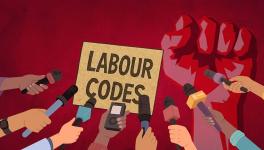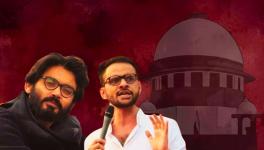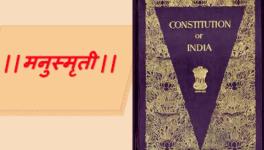Why 6 December Has Become Just Another Date in Ayodhya
Ayodhya on 6 December is as calm as the waters of the Sarayu. After the Supreme Court verdict of 2020 and the construction of the temple began, most people have forgotten what happened in Ayodhya on this date 29 years ago. Those who still have sad memories do not want to recall them. The people of Ayodhya feel something is up when media persons visit or police and security forces step up check-points. Even today, some people prefer to stay within their homes to avoid any commotion out-of-doors.
Those residents remember this anniversary who feel that a mosque was demolished by force, like in the 16th century, and no one got punished for it. Those who recall the anniversary also understand that not just a building was demolished but the country's Constitution. They question the entire system, from the credibility of the court's verdict to the assurances of the government that swore on the Constitution.
After the Supreme Court decision on the Ayodhya dispute, people breathed a sigh of relief that now they will no longer live on a battlefield, their avenues of livelihood will increase. They feel that the increase in arrivals of people from outside Ayodhya will improve their prospects. This possibility has the prices of land, not only Ayodhya but around it, soaring. Many instances of land scams and corruption came to the fore.
There are hundreds of shops on the roads leading to the Rama temple, which are the means of livelihood of the people of Ayodhya. Now the time has come for their demolition. Their owners of these properties have got compensation, but those whose bread and butter depended on them are helplessly wondering where they can go.
Roads have to be widened all around Ayodhya for the Rama temple. The old bus station, which was in the middle of the city, has already been demolished. The shops built around it were also demolished. A thousand families whose livelihoods were based on local fairs and festivals will soon lose their shops. The administration has made preparations to widen the road by demolishing their shops and homes. The matter cooled down during the COVID-19 lockdown, but now the sword of demolition is hanging over their heads again. Any day, the bulldozers of the administration could land on them. These people have twice registered their resistance in protest against the demolition by organising complete shutdowns of Ayodhya. But now they say, 'Whatever Lord Rama has decided will happen.'
The Muslims of Ayodhya have worn the cloak of complete silence. They are quiet, raise no questions. Salim (name changed), says on 6 December restrictions that everything is fine--on 6 December, the mosque was demolished, now the temple is being built. Earlier, Muslims would keep their shops and establishments closed to mark 1 February, the day the locks were opened, and 6 December, the day of the demolition. Now, no one keeps their shops closed for any day in Ayodhya.
The number of visitors to Ayodhya is up. People are going about their day calmly; there's not a wrinkle on anyone's face.
Anand, who runs a utensil store in Shringarhat, says that 6 December is done and dusted now. Everything happened for the Rama temple, and now it is being built. Devotees who wanted to visit Ayodhya would face problems due to restrictions. Those problems are also gone. Deepu runs a paan shop. He says people's attitudes have changed to 'Now let us look forward to Naya Roshan Ayodhya—Shining New Ayodhya'. Earlier, there were problems of all kinds on 6 December.
Bajrang Prasad, who set up a prasad shop at Hanumangarhi, says that now people no longer have 6 December on their mind. They are busy with their livelihoods. When the government and administration start preparations, people realise 6 December is coming.
Vikas, who runs a small hotel near Dashrath Mahal, says that if the media or news channels do not come to Ayodhya, people will completely forget what happened on 6 December. Earlier, all of Ayodhya used to get sealed. Everything would get shut. There used to be a lot of problems, but now it is not so. After the decision of the Supreme Court, the rituals of both "Yomei Gham" and "Shaurya Diwas" have ended in Ayodhya. Now people only hope their standard of living will improve after the construction of the temple.
Business-minded people have bought a large number of land parcels in Ayodhya. A big office of the Rashtriya Swayamsevak Sangh (RSS) has also opened. The members of the political party that ran the (ramjanmabhoomi) movement are in power and hold the highest offices in the temple construction trust. Nripendra Mishra, who was the principal secretary to Chief Minister Mulayam Singh Yadav at the time of the firing [on kar sevaks] in 1990, is the chairman of the Ram Mandir Construction Committee. On the other hand, in view of the upcoming Uttar Pradesh Assembly election, in their speeches and on public forums, BJP leaders have started talking about the firing that occurred 31 years ago during the chief ministership of Mulayam Singh Yadav on kar sevaks who were fighting for the demolition of the Babri Masjid.
The public is calm. Now, the agitation is within the BJP government of Uttar Pradesh. After all, elections are around the corner. The government is all about promises of development, but everyone from Chief Minister to Deputy Chief Minister and its minor leaders are remembering the firing incident from 31 years ago. The statement of Chief Minister Yogi Adityanath during the Deepotsav in Ayodhya about the devotees of Krishna matters: The next time there is kar seva, no bullets will be fired upon Rama and Krishna devotees. Instead, flowers will be showered. On 3 November, Deputy Chief Minister Keshav Prasad Maurya tweeted that after the construction of the grand temple at Ayodhya, now it is the turn of Kashi-Mathura. And there are other such remarks.
The construction of a grand Rama temple at Shri Ram Janmabhoomi and 6 December 1992 are like two wheels of a chariot. On 6 December 2021, the BJP is organising a meeting of its leaders from village to city to use the Ayodhya case against its political opponents in a new way. Its leaders are telling people why a BJP government is necessary for Uttar Pradesh: if there had been a BJP government in 1990, they say, there would have been no bullets fired on Rama bhakts. Are such remarks an indication of the political agenda of the BJP? If the agenda of Ayodhya ends with the construction of the temple, then the new agenda may have to be Mathura.
When programs were announced for Mathura by several self-proclaimed Hindutva organisations on 6 December, it included some people from Ayodhya. They were contenders for BJP tickets in the Mayorial election and had shared space on public platforms with the Chief Minister. They They include Mahant Rajudas of the Ayodhya Hanumangarhi temple.
Posters have been put up on the walls of Ayodhya, which call for going to Mathura. The slogan in the poster of Krishna Janmabhoomi Muktidal is: "6 December, Let's go to Mathura for the Kashi Sankalp Yatra." The motto of its organisation is, "Ahimsa Paramo Dharmah Dharma Hinsa Tathaiva Cha" i.e. non-violence is the supreme religion of man, but doing violence to protect religion is even better.
After the Supreme Court's final verdict on Ayodhya, dozens of petitions have been filed in the courts for Kashi and Mathura using the same arguments. Despite the 1968 agreement for the Krishna Janmasthan and the Shahi Masjid, members of the BJP are trying to raise a new movement under different banners. Many security forces have been deployed in Mathura to deal with any untoward situation on 6 December. According to Uttar Pradesh ADG, Law and Order, Prashant Kumar, the PAC and paramilitary forces have been deployed in the state as a precaution. Separate security arrangements have been made for Ayodhya, Mathura and Varanasi to ensure only traditional events take place.
The Ayodhya office-bearer of the Hindu Mahasabha, Rakeshdutt Mishra, has spoken up against a ban on 'Jalabhishek' in Krishna Janmabhoomi Mathura on 6 December. Its members will pledge to free Shri Krishna Janmabhoomi from the encroachment of the Idgah Masjid by performing jalabhishek of 'Laddu Gopal' across the country.
Now that the construction of the Rama temple is on, the BJP needs newer issues to form more governments.
Slogans used to be raised in the Ayodhya movement, 'Teen nahi hain teen hazar, nahi bachegi ek mazaar—We are not three but three thousand, not one mazar will be left standing'. 'Ayodhya toh ek jhanki hai, Kashi-Mathura baaki hain—Ayodhya is just a trailer, Kashi Mathura are still left.'
Khaliq Ahmed of the Helal Committee in Faizabad says that people should seriously examine why the Supreme Court exercised its special powers under the Constitution to order the government to allot land in lieu of the Babri Masjid. On 6 December, not just a mosque was demolished—the Constitution of India, orders of courts and assurances of the Chief Minister who swore on the Constitution to ensure security—all became meaningless.
The state government has given five acres of land in Raunahi, 27 km from Ayodhya city, to the Muslim side on the direction of the Supreme Court. There, all activities are in cold storage. Athar Hussain, Secretary, Indo-Islamic Cultural Foundation, Ayodhya, says that a map [of the planned construction] has been submitted to the Development Authority, they are awaiting clearance. Haji Mehboob, a party to the Ayodhya dispute on behalf of the mosque, used to organise a meeting to mark 'yomei gham' [barsi] in his own home. No program was organised this time. He says that Muslims were of the opinion that they would accept the decision of the Supreme Court. And we are accepting it. The temple being built there is a symbol of Hindu-Muslim unity. There is silence at the residence of Iqbal Ansari, son of Hashim Ansari, who was the main party to the dispute for years. In Karsevakpuram as well, there is no longer any need to organise a Shaurya Diwas.
More and more people come to Ayodhya to see the temple's construction. A businessman running a big hotel here says that the number of luxury buses to Ayodhya has also increased along with the number of pilgrims. After seeing Ayodhya under the glare of the media, these tourist pilgrims are disappointed when they see Ayodhya on earth. Now many state governments are competing over the Ram Mandir Darshan in Ayodhya. They want to get the elders of their state to see the Ayodhya Darshan free of cost. So far, people have come for Ayodhya Darshan on three free/state-organised special trains.
Ayodhya, which has been a playing field for religious politics since 1949, is now at the end of its political chapter. Now, 6 December has become just another date. Calendar dates keep changing. Similarly, 6 December will also come and go because much water has flown into the Sarayu in these past 29 years.
The author is a journalist based in Faizabad-Ayodhya. The views are personal.
Get the latest reports & analysis with people's perspective on Protests, movements & deep analytical videos, discussions of the current affairs in your Telegram app. Subscribe to NewsClick's Telegram channel & get Real-Time updates on stories, as they get published on our website.























